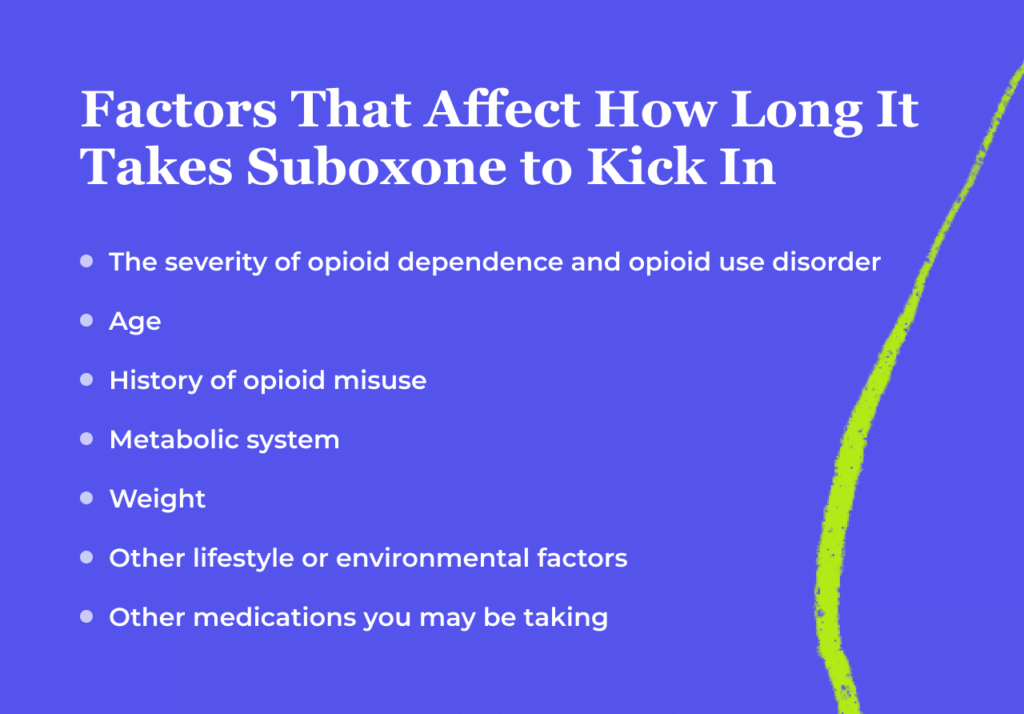
Generally, it takes 20 to 60 minutes for the first dose of Suboxone to start working.[1]
The drug reaches its peak approximately 1.5 to 3 hours after it is administered. It is then pharmacologically active for approximately the next 24 hours.

Factors That Affect How Long It Takes Suboxone to Kick In
The actual time it can take for Suboxone to “kick in” depends on many different factors.
Your dose might take longer to produce the desired effects depending on the following:
- Age
- History of opioid misuse
- The severity of opioid dependence and opioid use disorder
- Metabolic system
- Other lifestyle or environmental factors
- Weight
- Other medications you may be taking
Suboxone Pills vs. Strips
There are two methods of administering Suboxone: tablets (pills) and strips.[2] Both take effect within about 20 to 60 minutes. Both are dissolved under the tongue instead of swallowed.
Regardless of the method of administration, both Suboxone pills and strips begin to work in the body equally quickly after being absorbed under the tongue.
How Long Does It Take for Suboxone Pills vs Strips to Kick In?
Most patients on Suboxone therapy receive their medication in strip form, but some also use the tablets/pills. Suboxone pills take ever so slightly longer to dissolve under the tongue than strips, maybe by a minute or two. However, once absorbed, the time to relieve symptoms is essentially the same.
What to Do if You Don’t Feel Anything
It is important to wait to initiate your Suboxone until you are in active withdrawal and only after other opioids are out of your system.[3]
Before you take your first dose, you should wait until you are actively in opioid withdrawal—otherwise, you will experience precipitated withdrawal symptoms.
Waiting Until Opioid Withdrawal Symptoms Appear
Everyone’s body is different and the best way to tell if you are in withdrawal is simply to examine how you feel. Common opioid withdrawal symptoms include: [4]
- Fever and chills
- Nausea, vomiting, diarrhea
- Sweating
- Yawning
- Anxiety
- Muscle aches
- Teary eyes and runny nose
- Stomach cramping
- Goosebumps
How Long to Wait Based on the Opioids You Use
If you are not sure if you’re in active withdrawal, a good rule of thumb is to wait approximately: [5]
| Type of Opioid | Examples | How Long to Wait |
| Short-acting opioid | Heroin, Percocet, Vicodin (hydrocodone) | 12-24 hours before taking Suboxone |
| Long-acting opioid | Morphine, OxyContin | 36 hours before taking Suboxone |
| Long-acting opioid | Methadone | 48 hours before starting Suboxone |
Always Consult Your Doctor or Treatment Team
Always consult your treatment provider before initiating Suboxone, as these times vary significantly from person to person and depend on what kind of opioids were used prior.
If you don’t feel like the Suboxone is having any effect 2-4 hours after the first dose (that is, you still feel the opioid withdrawal), your provider may advise you to take another dose that same day (which is often between 2 mg and 4 mg).
If your initial experience is that the Suboxone is not having any apparent effect, this is not a cause for concern.[6] Simply inform your treating provider, and they can help adjust the Suboxone to find the dose that’s right for you.
How Long Will Suboxone Effects Last?
When taken on schedule (typically once or twice a day, at the same time every day), Suboxone works effectively to manage opioid withdrawal symptoms.[7] For most people, Suboxone prevents withdrawal for 12-24 hours, which is why people take it once a day, but sometimes more frequently, up to two or three times a day.
Based on your medical profile and history, your doctor will give you a customized prescription of online Suboxone to maximize its benefits and minimize its side effects for you individually.

Medically Reviewed By Elena Hill, MD, MPH
Elena Hill, MD; MPH received her MD and Masters of Public Health degrees at Tufts Medical School and completed her family medicine residency at Boston Medical Center. She is currently an attending physician at Bronxcare Health Systems in the Bronx, NY where ... Read More
Download Our Free Program Guide
Learn about our program, its effectiveness and what to expect
Related Content
Imagine what’s possible on the other side of opioid use disorder.
Our science-backed approach boasts 95% of patients reporting no withdrawal symptoms at 7 days. We can help you achieve easier days and a happier future.
